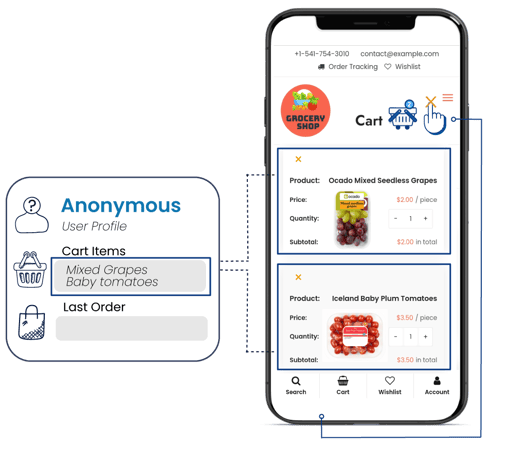Combine behavioural and customer data for personalised
messages to all your push channels.
App push, web push, email, SMS and postal.
In direct marketing, you typically run campaigns using data you have collected about your customers that are stored in your CRM or data warehouses. With the help of an ID Graph, you can combine this information with behavioural information from your digital touchpoints to run time based campaigns with additional behavioural attributes or behavioural trigger campaigns.
What are trigger based messages?
Behavioural trigger messages are marketing messages that are automatically sent to customers based on specific online behaviours and events.
These messages are highly personalised and timely, and can help increase:
- Customer Engagement
- Retention
- Conversions

If visitors are browsing your web or app anonymously,
how can you engage with them?
1. Cart Abandonment
An effective sales recovery tactic is to send a cart abandonment notification to customers who have added products to their cart but failed to check out. These engagements are a great opportunity to increase the average ticket, either by upselling or cross selling, because the opening rates of abandoned cart reminders are much higher than of other marketing emails. But how can we notify the customers if they abandon their carts while they are not logged-in on our media?
Step 1.
A customer is shopping on your website without log-in, but before finishing the checkout process, the client abandons the shopping cart.

Step 2.
Teavaro resolves the identity and links it to her existing customer data, like previous purchases. One of her favourite products is lemon juice, which is currently on offer.

Step 3.
If after some time, the customer has not completed the checkout process, a message is automatically sent (email, app push, SMS, etc.) with a reminder and the cross selling offer for lemon juice.

2. Product recommendation
When we see that users have interest in a product, we can guide them down the purchase funnel with personalised trigger emails reminding them about the product or service they have visited and offering extra value by adapting the message to their needs at that moment of interest. But how can we know who to send these emails if the user is not logged-in on our media? And furthermore, how can we personalise the email to their specific needs? This is how we it:
Step 1.
A visitor shows interest in cosmetics but is not logged-in.

Step 2.
Teavaro resolves the identity and links it to the customer data. Our algorithms catalogue her as vegan, based on previous purchases and online behaviour. You can also retrieve her contact data, and check if she has consented to receive commercial communications.

Step 3.
You can send a retargeting email with the recommended product based on her online behaviour (cosmetics search) and personal needs (vegan).

Benefits of behavioural direct marketing.

Higher open and click through rates.

Improved conversion rates.

Increased customer loyalty.

Increased Customer Life Time Value.

Case Study
Our customer wanted to leverage behavioural data (app & web) combined with customer data in near real-time for shopping cart abandonment and product buying propensity.

Your First-Party ID Graph is the foundation
for the following use cases.
You can see real examples from our customers and
how they benefit from our solution.

Build your First-Party
ID Graph.


Onsite
Personalisation.

Behavioural Direct Marketing.

Targeting in Walled Gardens.

Targeting in the
Open Web.


